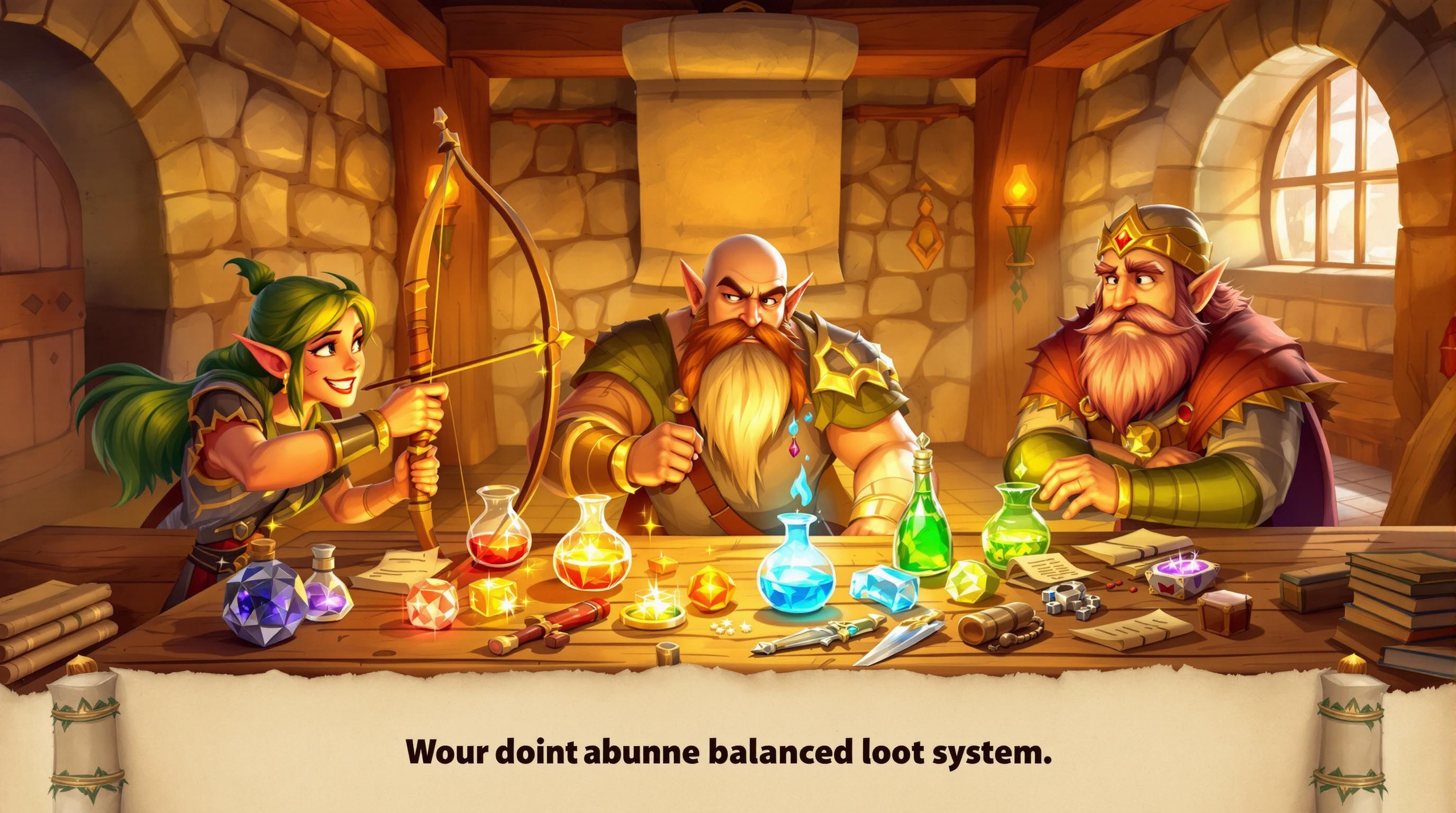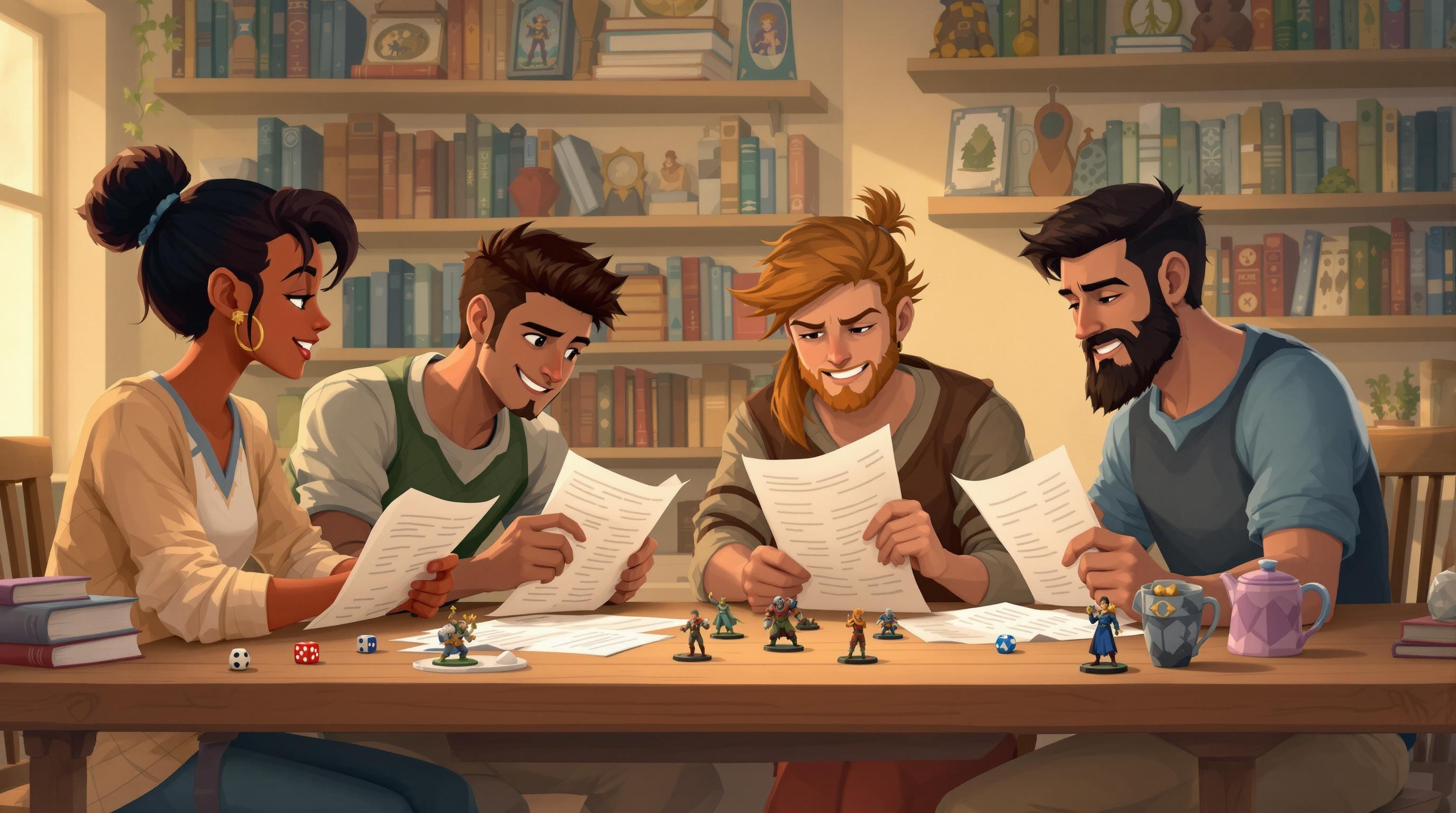Balancing racial traits in tabletop RPGs ensures fair gameplay and diverse character options. This guide simplifies the process into 5 steps:
- Set Core Standards: Define ability modifiers, skill proficiencies, and unique abilities for each race while maintaining balance.
- Make Each Race Different: Avoid overlapping traits and align abilities with lore for unique identities.
- Add Costs and Benefits: Balance strong abilities with meaningful trade-offs using a point-based system.
- Test and Adjust: Playtest traits across scenarios and refine based on player feedback.
- Plan for Growth: Ensure traits remain relevant and balanced across all character levels.
These steps help create racial traits that are fair, engaging, and lore-friendly, enhancing the overall gaming experience.
Step 1: Set Core Standards
The first step is to create a framework that will guide the design of racial traits, ensuring they are distinct and balanced.
List Basic Traits
| Core Component | Common Examples | Purpose |
|---|---|---|
| Ability Score Modifiers | +2 Constitution for Dwarves | Highlight physical or mental strengths |
| Skill Proficiencies | Perception for Dwarves | Showcase cultural expertise |
| Special Abilities | Darkvision, Resistances | Add flavor with unique features |
These baseline traits should align with game mechanics to maintain balance and progression. For example, Pathfinder 2E distributes racial abilities evenly across levels to ensure consistent development [3].
"Game balance isn't just between different player options, but also about making sure the game as a whole is, in fact, a game, with a certain degree of failure as well as a degree of success being possible."
Measure Power Levels
Establishing power benchmarks early helps avoid imbalances in racial traits. Key factors to evaluate include:
- Combat and Non-Combat Utility: How useful are the traits in different scenarios?
- Frequency of Use: How often can these traits be activated?
The human race is often used as a baseline, with other racial traits measured against it. This approach helps flag potential balance issues during the design phase [3].
For instance, elves in Pathfinder 2E are designed with bonuses to Dexterity and Acrobatics, reflecting their lore while maintaining gameplay balance [3][4].
Once core standards are set, the next step is to develop traits that emphasize each race's individuality and lore.
Step 2: Make Each Race Different
Now that the core standards are set, the next step is to ensure every race feels unique and fits its identity. Building on the groundwork from Step 1, this step focuses on making each race stand out both mechanically and thematically.
Avoid Overlapping Abilities
To keep races distinct, track their abilities carefully and avoid duplicating features across races or classes.
| Design Focus | Implementation Strategy | Example |
|---|---|---|
| Unique Mechanics | Use different game systems for abilities | Fire resistance vs. fire absorption |
| Power Distribution | Spread abilities across various areas | Combat, social, exploration |
| Activation Types | Mix up how abilities are triggered | Passive traits vs. active abilities |
A race's abilities should enhance its identity without stepping on the toes of class features. For example, if a class specializes in fire-based spells, the race could focus on frost-related abilities instead, keeping both distinct [1].
Once the mechanical differences are clear, tie these traits to the race's lore for a more immersive design.
Align Traits with Lore
Racial traits should naturally reflect the race's background and history within the game world.
When designing lore-based traits, think about:
- Environmental factors: How has their habitat shaped them?
- Cultural influences: What traditions or practices define them?
- Historical significance: Do their abilities stem from key events in their past?
For instance, a race that thrives in volcanic regions might have traits like lava-walking or immunity to ash clouds [1][2].
Keep both immediate gameplay effects and long-term potential in mind. Every trait should have a clear purpose while seamlessly fitting into the race's story and world.
Step 3: Add Costs and Benefits
Once you've defined the unique traits for each race, the next step is to create a balanced system of strengths and weaknesses. This ensures gameplay stays fair while keeping each race's identity intact.
Balancing Abilities with Trade-offs
Strong racial abilities should come with meaningful drawbacks to maintain balance. Here's a simple framework to guide you:
| Ability Type | Trade-off Type | Example |
|---|---|---|
| Major Ability | Direct Weakness | Fire immunity paired with vulnerability to cold |
| Passive Bonus | Resource Limitation | Night vision offset by sunlight sensitivity |
| Combat Advantage | Social Consequence | Increased strength but difficulty in diplomacy |
The goal is to design trade-offs that encourage players to make strategic choices, rather than just dealing with flat penalties. For instance, a race with incredible strength might struggle in negotiations, reflecting a cultural emphasis on physical power over social skills [1].
Using a Point-Based System
A point-based system can help create a structured way to balance these traits. Here's how it works:
- Assign points to traits based on their power and usefulness, giving all races the same point budget.
- Use both positive and negative points to account for strengths and weaknesses.
- Allow some flexibility, but keep the structure consistent.
When evaluating traits, think about factors like:
- How useful they are in combat
- Their value during exploration
- How they affect social interactions
- Whether they work well with different classes
- How they impact gameplay over time
This approach ensures racial traits feel fair and fit well into the game's theme. Once you've balanced everything with clear trade-offs and a point system, the next step is to test these mechanics in gameplay to see how they perform.
sbb-itb-b8b00a5
Step 4: Test and Adjust
Testing racial traits during gameplay is essential to spot balance issues and ensure they contribute positively to the player experience. This involves analyzing gameplay data and fine-tuning traits for the best results.
Run Test Games
Testing helps confirm whether the costs and benefits you established earlier work well in real gameplay. Use diverse test groups to see how racial traits perform across different play styles and situations.
| Test Scenario | Focus Areas | Key Metrics |
|---|---|---|
| Combat Encounters | Damage output, survival rates | Combat round duration, healing required |
| Social Interactions | Diplomatic advantages, NPC reactions | Success rates in negotiations, NPC responses |
| Exploration Challenges | Movement abilities, resource usage | Obstacle completion time, resource usage |
| Class Combinations | Synergies with different classes | Build effectiveness, ability interactions |
Keep track of how often players use racial traits and their impact on outcomes, such as damage dealt, negotiation success, or adaptability in tough environments. Use this data to refine traits and improve balance.
Update from Results
"Playtesting reveals imbalances that may disrupt gameplay." [5]
Analyze gameplay data, gather player feedback, and test specific edge cases to find any imbalances. For instance, combining high-damage racial traits with combat-heavy classes could reveal issues that need fixing.
"To balance a race's distinctiveness and legibility, it is best to be able to describe the differences in terms of a few, large differences." [1]
When making adjustments, preserve the unique identity of each race. If a trait is causing problems, consider replacing it with one that aligns better with the race's theme rather than just tweaking numbers.
For inspiration, check out the TTRPG Games Directory, which showcases how other systems handle racial trait balancing. It can provide useful ideas for refining your own designs.
Step 5: Plan for Growth
Keeping racial traits balanced and useful as characters progress is key to maintaining engaging gameplay. As characters level up, their racial abilities should stay relevant - offering benefits without becoming too strong or irrelevant.
Test High-Level Play
Racial traits that work well early on, like poison resistance, might lose their appeal at higher levels. To address this, consider adding level-based bonuses to keep these traits useful. For instance, a trait could start with a +1 bonus at level 1 and grow to +3 by level 10, ensuring it scales appropriately.
| Level Range | Focus Area | Approach |
|---|---|---|
| Low levels | Core effectiveness | Establish baseline strengths |
| Mid levels | Synergy with classes | Balance traits with class abilities |
| High levels | Scaling management | Avoid excessive power increases |
Scaling traits thoughtfully helps maintain balance across levels, but it's equally important to align them with the specific tone and challenges of your campaign.
Align with Campaign Themes
Racial traits should reflect the campaign's setting and style. For instance, a high-fantasy campaign might prioritize magical abilities, while a survival-based game might focus on traits suited for harsh environments.
"Playtesting reveals imbalances that may disrupt gameplay." [5]
Use feedback from high-level playtesting to fine-tune scaling and ensure traits match the campaign's themes and challenges effectively.
Conclusion
Designing racial traits that enhance gameplay involves careful planning and attention to balance. By focusing on a few key principles, designers can create options that are engaging and align with the game's lore.
When crafting racial traits, aim for choices that are balanced, scalable, and flexible enough to suit a variety of character concepts. Avoid falling into the trap of stereotypes or overly rigid archetypes, and instead, prioritize traits that feel distinct and meaningful within the game's mechanics [1].
For additional ideas, check out the TTRPG Games Directory. This resource showcases how different systems approach racial traits, offering valuable examples of what works well and what to avoid.
Playtesting and player feedback are essential throughout the process. Regular updates based on real gameplay insights ensure the traits remain fair, enjoyable, and engaging for everyone involved.


